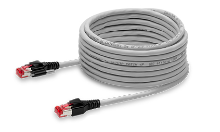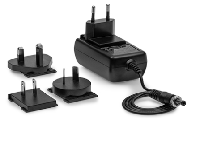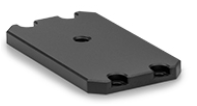|
||||||||||||||||||||||||||||||||||||||||||
|
||||||||||||||||||||||||||||||||||||||||||
iDS NXT Ocean: A simplified Artificial Intelligence workflow experience
Back
to Newsletter
Go to iDS NXT Ocean Product Page
Go to
iDS Cameras
Go to High-resolution Colour Cameras
Go to High-resolution Monochrome Cameras
Go to GigE Cameras
|
iDS NXT Ocean editorial three of four: How to train an inference model for the IDS NXT ocean AI workflow |
|
|
Throughout this four-part series, we will continue to take you through
the steps to implement your own AI based image processing with the
all-in-one iDS NXT Ocean. The four basic steps to your AI solution
are: grab, label, train and run AI.
In part-two, we covered the steps required to upload images to the iDS NXT Lighthouse web-based AI training service and explain how to apply labels and annotations to the images for classification and object detection tasks. |
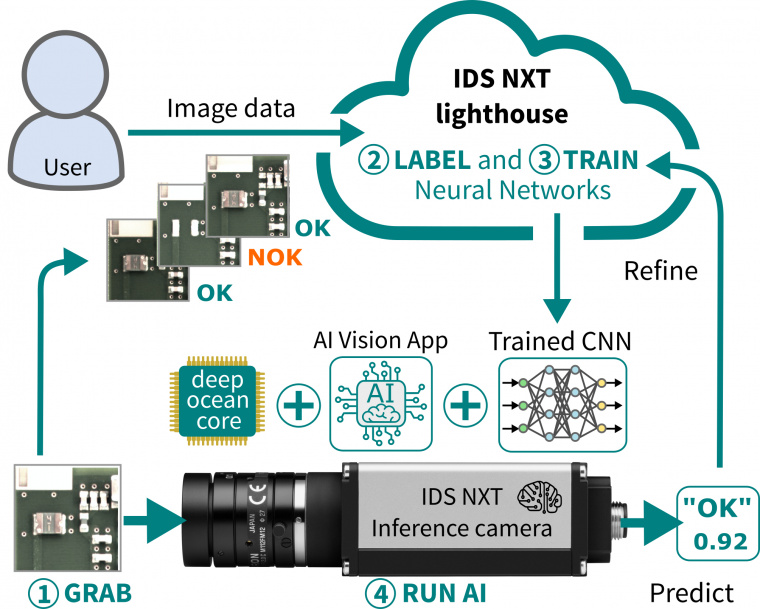 |
|
In this editorial, part-3, we will focus on the training process and how to build neural networks to run successfully on your camera. To
complete the training process the web application iDS NXT Lighthouse
is used. iDS NXT Lighthouse is a cloud-based online platform. It
enables users to manage images to train a model for AI based image
processing tasks and to create the individual neural network. To
gain access to iDS NXT Lighthouse, users must log-in and start a
new project by clicking the ''add" button and by choosing the
project type. Users have the option to choose between classification
and detection. We will provide an example for both of these options.
|
|
|
Following
this, users will select the data set they wish to use. The data
set tab, located near the top of the page, provides your chosen
thumbnail image, a summary of the data set, a number of corresponding
annotations and the number of images chosen for the data set.
On the right of the data set tab you can select the utilization
drop down box, which allows the selection of what proportion
of images will be used for training and what percentage will
be used for validation. The default is a 70/30 (training/validation)
split but users can customize based on their own preference.Once
you have selected your data set and what proportion of the images
will be used for training and validation you can test your data
set for training. The next section is related to the neural network requirements. In this section, users can choose the iDS NXT OS version - in most cases it is recommended to use the latest version, however for compatibility with existing deployed systems the appropriate version can be selected from the drop down list. Users will now choose the inference time. You can choose options between 13-milliseconds to 75-milliseconds - the appropriate selection is based on the necessary decision time for the system balanced against the accuracy requirements. In some cases it can be helpful to create multiple neural networks with different inference times in order to compare performance. Once you have selected these parameters click "train neural network" to begin the training process. During
the training NXT Lighthouse provides a graph which documents
the achieved accuracy for the training sequences of the neural
network. |
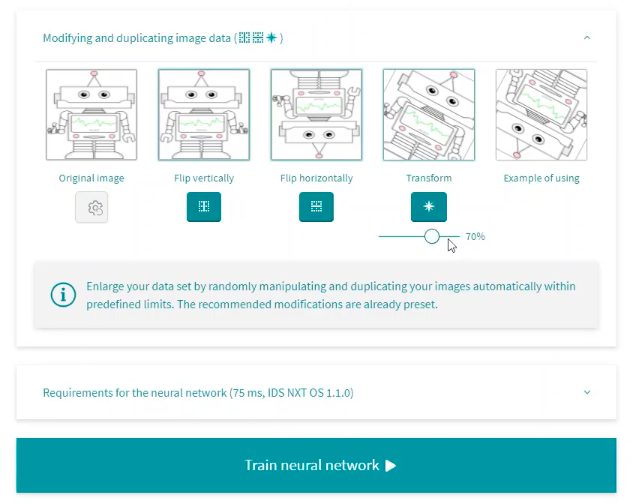 Image: iDS NXT Lighthouse offers a data augmentation tool which allows you to rotate, zoom, shift, distort and shift colour channels in order to improve application outcomes |
|
Training
neural networks for tasks related to object detection on iDS NXT
Lighthouse provides the same high level data augmentation except
for the image flipping tool. For detection we will select the maximum
degree of variation for the data augmentation aspect. After this
stage users will click to the train neural network button.
Object detection does not allow you to choose the inference time, it is fixed at 132 milliseconds because of the neural network architecture. |
|
|
In
the next editorial we will discuss how to run the AI Inference
on the camera once it has been created. The NXT Ocean package
is designed specifically for tasks related to object detection
and classification.This workflow maximises the efficiency of
your application as it makes it a lot simpler and more flexible.
The iDS NXT Ocean package can be purchased as individual components
or in a kit to simplify initial purchase. See below for more
information on this kit.
|
|
| What the iDS NXT Ocean kit includes | |
|
iDS
Rio camera with |
iDS NXT Rio is a fully-fledged standard industrial camera that can execute neural networks with hardware acceleration giving inference times of a few milliseconds thanks to the integrated, specially developed AI core ("deep ocean core"). Thanks to features such as C-Mount, GigE network connection with RJ45 connector, a serial RS232 interface and REST web interface, this model is ideally suited for use in industrial environments. With the Sony global shutter CMOS sensor the camera is suitable for customers with high demands on image quality, dynamic range and sensitivity. It provides a resolution of 1.6 MP at 3.45 µm pixel size. The iDS NXT Rio GS29016 is available in monochrome or colour. |
|
6
Month license for
|
|
|
The
iDS NXT Lighthouse cloud software allows those without expertise
in the area of artificial intelligence or camera programming to
train an AI classifier with their own image data. As a web application,
the necessary means to create the neural network are immediately
available, meaning you wont have to initially set up your own development
environment.
Subsequently you can start on your own neural network straight away. Image processing can take place entirely or partially on the camera FPGA, this reduces bandwidth and computing load. |
|
| The iDS NXT Ocean kit also includes: | |||
|
High quality lens
|
Gigabit Ethernet Cable
|
Camera power supply with necessary adapters
|
Camera tripod adapter
|
|
Specifications
|
iDS
NXT Rio GS29016
|
||
|
Sensor
Type
|
CMOS
Colour
|
||
|
Shutter
|
Global
Shutter
|
||
|
Sensor
characteristic
|
Linear
|
||
|
Resolution
|
1456
x 1088 Pixel
|
||
|
Pixel
Size
|
3.45
x 3.45 um
|
||
| Need
a price or more application information? Please
email Adept Turnkey or call our offices Adept Turnkey Pty Ltd is "The Machine Vision and Imaging Specialists" and distributor of iDS products in Australia and New Zealand. To find out more about any iDS product, please call Adept Turnkey at Perth (08) 9242 5411 / Sydney (02) 9905 5551 / Melbourne (03) 9384 1775 or contact us online. |
|||
|
If you like this page, please recommend and share it. |
|||
| More | |||






